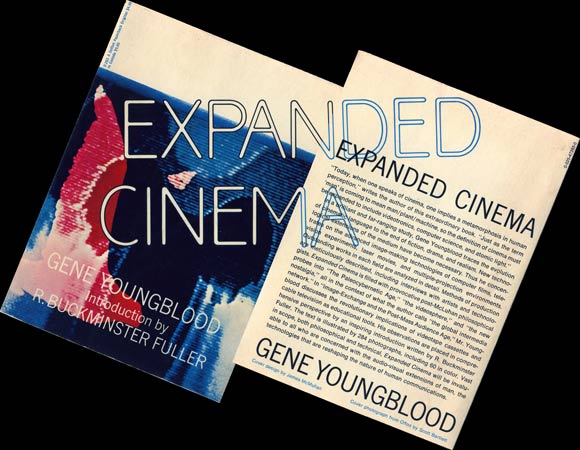Gene Youngblood: Expanded Cinema (1970)
Filed under book | Tags: · art, art history, computer film, computing, cybernetics, expanded cinema, experimental film, film theory, holography, intermedia, media art, multimedia, technology, television, video, video art

“The first book to consider video as an art form, was influential in establishing the field of media arts. In the book he argues that a new, expanded cinema is required for a new consciousness. He describes various types of filmmaking utilising new technology, including film special effects, computer art, video art, multi-media environments and holography.” (Wikipedia)
Part One: The Audience and the Myth of Entertainment
Part Two: Synaesthetic Cinema: The End of Drama
Part Three: Toward Cosmic Consciousness
Part Four: Cybernetic Cinema and Computer Films
Part Five: Television as a Creative Medium
Part Six: Intermedia
Part Seven: Holographic Cinema: A New World
Key words and phrases: Jordan Belson, expanded cinema, Nam June Paik, Buckminster Fuller, Stan VanDerBeek, videotronic, Ronald Nameth, Carolee Schneemann, John McHale, Expo 67, slit-scan, John Cage, light pen, Gene Youngblood, Otto Piene, Beflix, Howard Wise, KQED, Samadhi, WGBH-TV
Introduction by R. Buckminster Fuller
Publisher E.P. Dutton, New York, 1970
SBN 0525101527
432 pages
Reviews: Paul Cowen (Leonardo, 1972), Thomas Beard (Artforum, 2020), Caroline A. Jones (Artforum, 2020).
Analysis: Adam Sindre Johnson (2010, NO).
PDF (45 MB, no OCR, via Internet Archive, added on 2016-3-2)
PDF, PDF, PDF (5 MB, OCR)
PDF chapters
FLOSS Manuals: Pure Data (2006–)
Filed under manual | Tags: · floss, graphical programming, image, image processing, pure data, software, sound, sound processing, video, video processing

Pure Data (or Pd) is a real-time graphical programming environment for audio, video, and graphical processing. Pure Data is commonly used for live music performance, VeeJaying, sound effects, composition, audio analysis, interfacing with sensors, using cameras, controlling robots or even interacting with websites. Because all of these various media are handled as digital data within the program, many fascinating opportunities for cross-synthesis between them exist. Sound can be used to manipulate video, which could then be streamed over the internet to another computer which might analyze that video and use it to control a motor-driven installation.
GNU General Public License version 2
PDF (PDF)
PDF (EPUB)
View online (HTML)
bang. Pure Data (2006)
Filed under book, manual | Tags: · floss, graphical programming, image, image processing, pure data, software, sound, sound processing, video, video processing

“Pd (aka Pure Data) is a real-time graphical programming environment for audio, video, and graphical processing. Pd is free software. It is subject of a constant process of change, revealing new characteristics with each application. Is it a tool/media/instrument? Is this a question that can be answered? Is it a decision that needs to be made at all?
This publication is a compilation of texts describing different approaches to Pd, a profile of its usage and development. It is contradictory, and at the end, one finds oneself with a lot of open questions, on a technical level as well as on a philosophical one.
The 1st International Pd-Convention in Graz in fall 2004 was the motivation for this book. The authors participated at this meeting, and an accompanying DVD shows some of the works that were presented at this occasion.”
With articles from: Frank Barknecht, Reinhard Braun, Ramiro Cosentino, Günther Geiger, Thomas Grill, Cyrille Henry, Jürgen Hofbauer, Reni Hofmüller, Werner Jauk, Brian Jurish, Andrea Mayr, Thomas Musil, Michael Pinter, Miller Puckette, Marc Ries, Winfreid Ritsch, Andrey Savitsky, Christian Scheib, Susanne Schmidt, Hans-Christoph Steiner, James Tittle, Harald A. Wiltsche, IOhannes m zmölnig.
Edited by Fränk Zimmer
Publisher Wolke, Hofheim, 2006
Creative Commons BY-NC-ND 2.5 License
175 pages
PDF, PDF (7mb, updated on 2024-4-20)
Comment (0)
